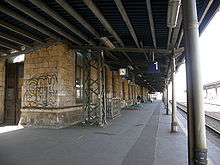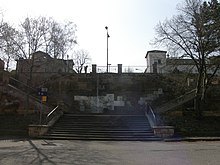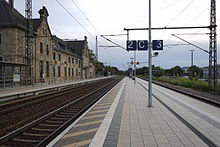Apolda train station
| Apolda | |
|---|---|
|
Reception building
|
|
| Data | |
| Design | Through station |
| Platform tracks | 3 |
| abbreviation | UAP |
| IBNR | 8011051 |
| Price range | 4th |
| opening | April 1, 1890 |
| Profile on Bahnhof.de | Apolda |
| Architectural data | |
| Architectural style | Neo renaissance |
| architect | Schmandt |
| location | |
| City / municipality | Apolda |
| country | Thuringia |
| Country | Germany |
| Coordinates | 51 ° 1 '51 " N , 11 ° 31' 34" E |
| Railway lines | |
|
|
|
| Railway stations in Thuringia | |
The Apolda station is a through station on the railway line Halle-Bebra in mittelthüringischen county town Apolda . It was opened on April 1, 1890 and is classified as station category 4 in the Deutsche Bahn station categorization.
location
The station is on the edge of the Heusdorf district at the northeast end of Bahnhofstrasse. The area is bounded in the south and west by Bahnhofstrasse and in the north by Sulzaer Strasse. The former track field is to the north of the through station and the station aprons to the east and west. The distance to the city center is approximately 1 km. Apolda train station is located at km 71.68.
History of the station
The station building from 1846
It is not known exactly when the first train station in Apolda was built and inaugurated. The building had two floors and was classified as classicism. There were various waiting rooms for 1st, 2nd and 3rd class in the train station as well as two restaurants, a ticket office, a telegraph and a baggage office. Before the signal box was built, there were also rooms for signaling systems. Upstairs there was an apartment for the station master and other rooms for the railway staff.
The station building from 1890
Apolda station was destroyed by a great fire on the night of September 24th to 25th, 1884. The "Apoldaer Tageblatt" reported on this fire on September 26, 1884:
“The station building of our train station is in ruins. At around 4 a.m. our fire brigade was alerted, 'the train station is on fire!' was the alarm signal. Shortly after 4:00 a.m., the first syringe was on the scene, which had to begin its work on the north side of the burning station building. At 3:45 a.m., the station master on duty cleared a freight train, hardly noticed the danger of the fire and at 4:00 a.m. the north side of the building was already in full flames. After a few minutes the roof structure burned in its entirety and the fire brigade's task could only be to limit the fire to the roof structure of the entire building. The land sprayer came into action at around 4.15 a.m. and all the fire-fighting equipment available to the local city was shortly afterwards, but it was not possible to save the building to such an extent that the first floor and the ground floor areas were spared, the fire spread with such violence that even the ground floor areas were completely destroyed by the falling, burning beams on the north side, where the restoration areas are located. Of the whole buildings, only the ticket, telegraph and baggage offices were spared, at least insofar as the fire could not act directly on these premises. It is assumed that the fire started before 3 a.m., but it is wonderful that at this point, where the service keeps some of the civil servants awake all night, where the danger could not be foreseen in time. "
Furthermore, the "Thüringer Tageblatt" wrote on September 27, 1884:
“Our train station today offers a picture of devastation. The station building has burned down completely, the south side of the same, which was believed to be saved yesterday, is also completely destroyed, so that only the surrounding walls remain. "
As a result, the Royal Railway Directorate Erfurt intended to build a barrack on the city-facing side of the railway site in order to accommodate various offices and catering facilities. This half-timbered barrack came from Roßlau, which today belongs to Dessau-Roßlau and is located in Saxony-Anhalt. A temporary building was removed from the railway site there and rebuilt in Apolda. This temporary station building, which was located between today's station and freight station, was put into operation on Sunday, December 14, 1884. It was not until two years later that the Royal Railway Directorate in Erfurt submitted a draft for a new station building. This action was preceded by numerous reminders and complaints from citizens and traders who no longer wanted to accept the poor connection to the railway network. Another three years later, on February 4, 1889, work began on the new building on the foundations of the old, burnt down station. On August 12th of the same year, the shell was ready and could be handed over to its intended use shortly afterwards. The provisional building from Roßlau was already auctioned towards the end of 1893, so that the leveling work could begin on April 2nd of the following year. The new station was opened on April 1, 1890. The building is made entirely of sandstone, in a mixture of German and Italian neo-renaissance styles. It is decorated with small turrets and decorative gables.
In the period from 1905 to 1908, the platforms received surface reinforcement and roofing. This happened on the basis of a petition from the city of Apolda to the Royal Railway Directorate in Erfurt. In addition, an underpass was built between the two platforms in 1906. During the First World War, the railway area was used as a war catering facility, for which some barracks were built. During this period, a toilet was also built. It was demolished around the turn of the year 1922/1923 due to excessive odor nuisance.
One of the special features of the interior of the entrance building, which was built in clinker construction, is the decoration with symbols from the symbolism of the Freemasons, but also a Star of David, which was not a traditional box symbol. So far it has not been clarified what significance this marking has.
The train station today
Reception building and platforms
The station building was last renovated in 1988/1989. The outer facade was cleaned and the interior was embellished. As early as 1953, the previously open ticket office was divided into several work areas and a false ceiling was put in place. The ticket offices are only partially occupied during the week. Toilets are not available. There is a kiosk in the lobby. Parts of the premises are also used by a taxi company and the city of Apolda for seminars. The marshalling yard located directly next to the passenger station on its east side has been shut down and demolished.
The route is controlled by the Apolda electronic signal box .
The house platform was 297 meters long and 34 centimeters high. Like the other platform, it was roofed over and fortified between 1905 and 1908. The underpass between the two platforms was built in 1906. The platform between tracks 2 and 3 is 377 meters long and 55 centimeters high.
Between October 2012 and autumn 2013, the station was modernized in several construction phases and made barrier-free . First, the pedestrian underpass was rebuilt and platform 1 was rebuilt. Platforms 2 and 3 were then converted. The platforms are accessed by ramps and lifts and are equipped with weather shelters and a guidance system for the blind. By extending the pedestrian underpass, access to the future public transport interface of the city of Apolda was created. Dynamic font indicators are available for passenger information. The costs amounted to around 5.5 million euros.
| track | Length in m | Height in cm | use |
|---|---|---|---|
| 1 | 245 | 55 | Direction Großheringen |
| 2 | 245 | 55 | Direction Weimar |
| 3 | 175 | 55 | individual trains |
Station forecourt
The Apolda train station has no direct forecourt, only an access road, which is a dead end with a turning loop and can only be reached via Bahnhofstrasse. This was renovated in 1989 on the occasion of the 100th anniversary of the station and completely redesigned in 2016/2017 (in the run-up to the State Horticultural Show taking place in Apolda in 2017). Until then, the left and right edge of the lane will serve as partially chargeable parking and a taxi stand. Another access to this street and the train station is possible via the outside staircase built in 1934 from Ehringsdorf sand-lime brick .
Modernization of the station area
In 2014, the city of Apolda, in cooperation with Deutsche Bahn AG, created a park-and-ride car park on the former track field in the north of the station building. There are parking spaces for cars and buses as well as a bus stop. The platform underpass was punctured to make the square easier to reach, thus connecting the platforms with the new parking spaces. On February 29, 2012, the symbolic groundbreaking ceremony took place on the former site of the freight yard.
Transport links
Individual IC trains on the Leipzig - Eisenach - Karlsruhe / Düsseldorf route still stop on Fridays and Sundays . In the 2020 timetable, Apolda station will be served by the following lines:
| line | Course of the journey | Cycle (min) | operator |
|---|---|---|---|
| RE 16 | Erfurt - Weimar - Apolda - Großheringen - Bad Kösen - Naumburg - Weissenfels - Merseburg - Halle | 120 | Abellio |
| RE 17 | Erfurt - Weimar - Apolda - Bad Sulza - Großheringen - Bad Kösen - Naumburg | 120 | |
| RB 20 | Eisenach - Gotha - Erfurt - Weimar - Apolda - Großheringen - Naumburg - Weissenfels - Leipzig | 60 |
Since the Apolda train station is well outside the city center and larger residential areas, many passengers need to continue their journey by bus . Directly in front of the station building - before the opening of the P + R car park - the “Bahnhof” stop was set up, which was approached twice on weekdays by so-called midibuses . Above the outside staircase is the stop “Bahnhof / Freitreppe”, which is served 45 times on weekdays and 15 times on weekends.
Memorial site
Since August 18, 2009, two so-called “ stumbling blocks ” have been reminding of the function of the station during the Second World War , which were laid in front of the main entrance by the Cologne action artist Gunter Demnig at the suggestion of the Apoldaer Prager-Haus-Verein . On these plaques the names and dates of life of two Soviet Nazi slave laborers are given, who were unloaded dead from the wagons in March and August 1944, with which the Reichsbahn transported hundreds of people to Apolda for slave labor for armaments companies.
literature
- Apolda home. Contributions to the nature and local history of the city of Apolda and its surroundings. Born 1989/1996 Ed. Apoldaer Kulturverein e. V.
- Günter Fromm: From the history of the Thuringian railway and the Erfurt station , ISBN 3-929000-86-5 .
- Eva Gollrad: History and description of the city of Apolda 1871–1990 , Apolda o. J., ISBN 3-00-002012-8 .
- Kulturbund der DDR, Kreisorganisation Apolda: 700 years of the city of Apolda - 1289 to 1989 .
- Tourist Verlag Berlin: Railway Atlas GDR , ISBN 3-350-00293-5 .
Web links
- Representation of the track system as well as some signals and permissible speeds on the OpenRailwayMap
- Apolda train station and its history
- Station profile
- Platform information
Individual evidence
- ↑ Query of the course book route 580 at Deutsche Bahn.
- ↑ Modernized and barrier-free Apolda train station put into operation. Deutsche Bahn AG, October 25, 2013, accessed on November 1, 2013 .
- ↑ a b Platform information about the Apolda train station ( Memento of the original from April 18, 2016 in the Internet Archive ) Info: The archive link was automatically inserted and not yet checked. Please check the original and archive link according to the instructions and then remove this notice. on deutschebahn.com







